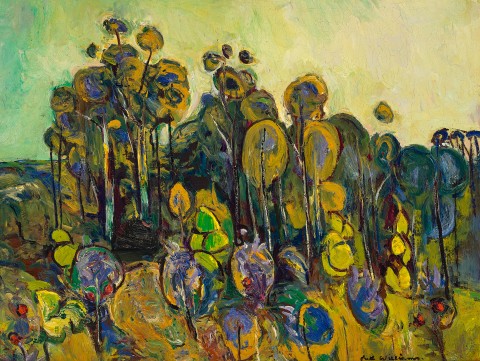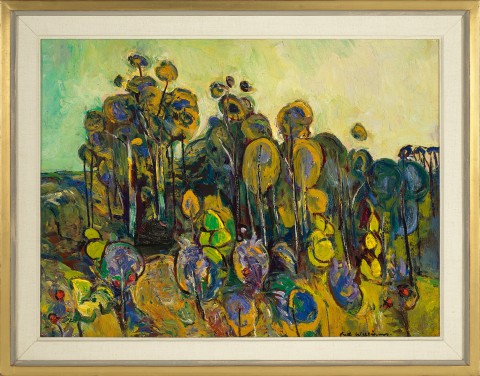TREES, 1958 – 59
FRED WILLIAMS
oil on composition board
51.0 x 68.0 cm
signed lower right: Fred Williams
Australian Galleries, Melbourne
Private collection, Melbourne, acquired in 1959
Private collection, Melbourne, acquired in 1968
Gould Galleries, Melbourne
Private collection, Canberra, acquired in 2007
possibly Recent Landscape and Still Life Paintings – Fred Williams, Australian Galleries, Melbourne, 12 – 21 May 1959, cat. 17
Gould Galleries, AAADA Antiques & Art Fair, Sydney, 22 – 26 August 2007, cat. 24
We are grateful to Lyn Williams for her assistance with this catalogue entry.
Like so many artists of his generation, Fred Williams left Australia, travelling overseas at the end of 1951, seeking exposure to broader artistic and cultural influences than those available to him in mid-century Melbourne. While his training had emphasised the centrality of the figure in Western art, following five years in London Williams saw opportunity and creative potential in the landscape of his own country and the focus of his art changed direction. His friend, John Brack, expressed reservations about the landscape – and particularly the ubiquitous gum tree – as a valid subject for contemporary painting, but Williams recognised it as part of a longstanding and respected artistic tradition which was ripe for new interpretation. Similarly, although the anti-picturesque qualities of his homeland seemed uninspiring to some, for Williams it represented the ideal subject:
‘It's perfectly true, it is monotonous… There is no focal point, and obviously it was too good a thing for me to pass up… the fact [that] if there’s going to be no focal point in a landscape [then] it had to [be built] into the paint… I’m basically an artist who sees things in terms of paint.’1
Writing about the landscapes Williams painted during the late 1950s, in the years immediately following his return to Australia, James Mollison observed that ‘his art swung from very expressive painting, frequently employing lush, thick paint freely applied, to austerity of paint and very simple means.’2 Trees, 1958 – 59 clearly falls into the former category and the artist’s pleasure in his medium, its fluidity and capacity for rich textural and painterly possibilities, is on full display. Williams’ skill as a colourist is also in evidence here; from the subtlety of the sky – progressing left to right from a delicate palette of greens and blues to an almost pearlescent glow – to the foreground foliage which is enlivened by dots and daubs of vivid colour. While such flashes of red, orange, yellow and purple are unexpected among the familiar muted tones of the Australian bush, here, they are perfectly realised and seem entirely at home.
The decision to paint the landscape was momentous for Williams and for the history of Australian art. The extensive oeuvre of paintings, prints and drawings that he created presented a new and unique vision of Australia – whether he was depicting a semi-rural hillside covered with scrubby bushes and trees, or an abstract aerial view of the desert thousands of kilometres away from any city centre – which would influence the way Australians saw and imagined their own country. Importantly, this focus also provided Williams with a rich and endlessly varied subject matter that would challenge his artistic development and sustain his interest throughout his career. This singular vision was recognised by the Sydney Morning Herald art critic who, soon after Trees was made, proclaimed, ‘There is every chance he will go down in history as Australia’s greatest landscape artist… Williams clarifies our vision, develops our understanding, defines our land.’3
1. Fred Williams, interviewed by James Gleeson, 3 October 1978, cited in Mollison, J., Fred Williams: A Singular Vision, Australian National Gallery & Oxford University Press, Canberra, 1989, p. 35
2. Mollison, ibid., p. 44
3. Thornton, W., cited in Grant, K. & Phipps, J., Fred Williams: The Pilbara Series, National Gallery of Victoria, Melbourne, 2002, p. 17
KIRSTY GRANT


